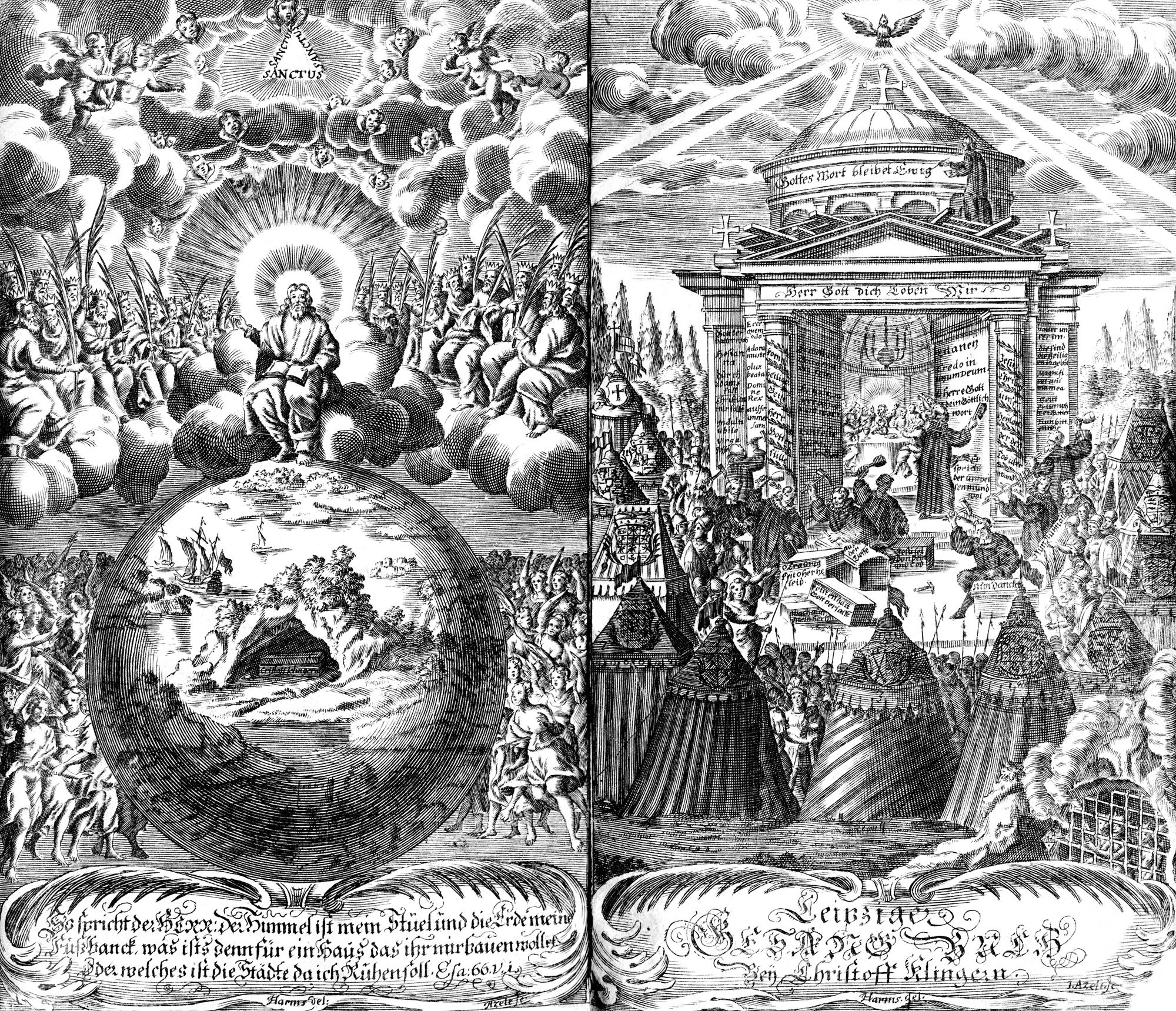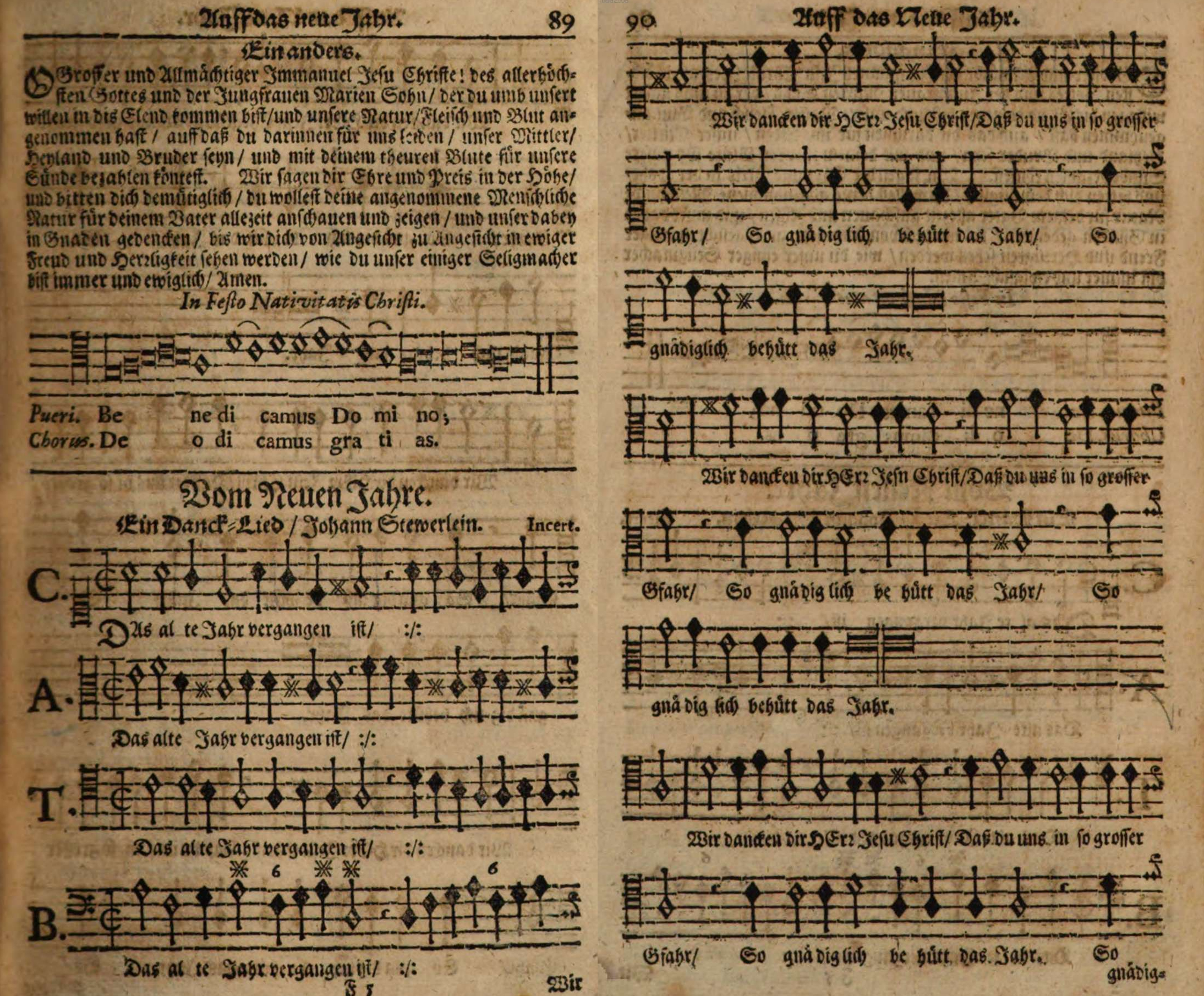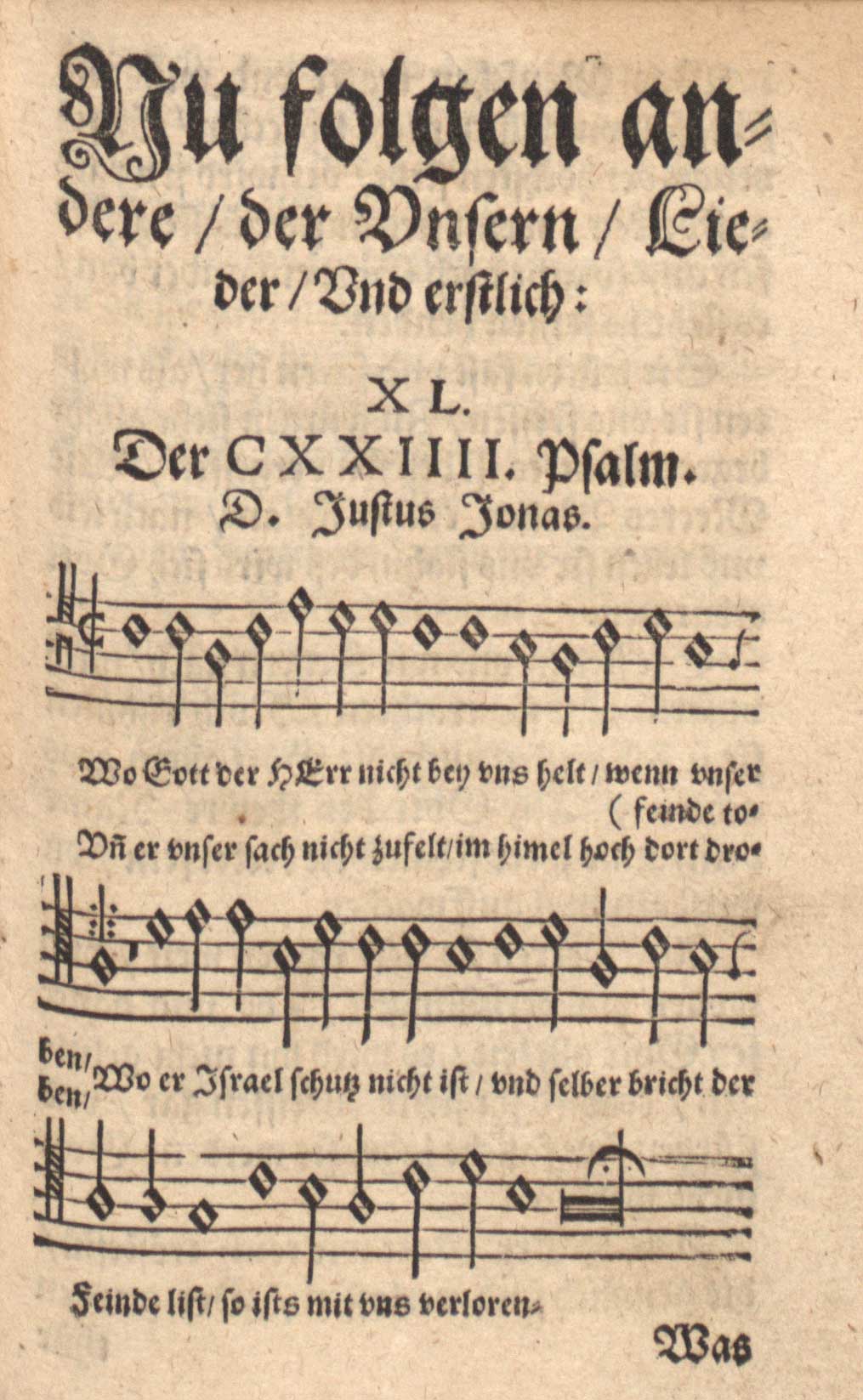|
Ach Lieben Christen Seid Getrost
"" (Ah dear Christians be comforted) is a Lutheran hymn in German with lyrics by Johannes Gigas, written in 1561. A penitential hymn, it was the basis for Bach's chorale cantata . History Johannes Gigas, also called Johannes Henne, wrote a hymn of consolation and penitence. It appeared first in Frankfurt an der Oder in 1561, mentioning Gigas as the author ("durch Johan. Gigas"). It was part of a hymnal ''Gesangbüchlin'' in Augsburg in 1570, and of a Leipzig hymnal of 1586. In an 1817 hymnal, it appears in the section "Trost in Sterbegefahr" (Consolation in danger of death). It has also been described as a penitential hymn. Lyrics The lyricist tries to give comfort to "dear Christians" (lieben Christen). From the second stanza, he uses the plural "uns" (us) including himself as part of a group united in the same situation. The text is in six stanzas of seven lines each: The lyricist is convinced that affliction may be a deserved punishment, and invites an attitude of penitent ... [...More Info...] [...Related Items...] OR: [Wikipedia] [Google] [Baidu] |
Lutheran Hymn
Martin Luther was a great enthusiast for music, and this is why it forms a large part of Lutheran services; in particular, Luther admired the composers Josquin des Prez and Ludwig Senfl and wanted singing in the church to move away from the ''ars perfecta'' (Catholic Sacred Music of the late Renaissance) and towards singing as a ''Gemeinschaft'' (community). Lutheran hymns are sometimes known as chorales. Lutheran hymnody is well known for its doctrinal, didactic, and musical richness. Most Lutheran churches are active musically with choirs, handbell choirs, children's choirs, and occasionally change ringing groups that ring bells in a bell tower. Johann Sebastian Bach, a devout Lutheran, composed music for the Lutheran church: more than half of his over 1000 compositions are or contain Lutheran hymns. History Lutheran hymnals include: * ''Achtliederbuch'', a.k.a. the first Lutheran hymnal (1524). Contains, among others, "Nun freut euch, lieben Christen g'mein", "Es ist das ... [...More Info...] [...Related Items...] OR: [Wikipedia] [Google] [Baidu] |
Gottfried Vopelius
Gottfried Vopelius (28 January 1645 – 3 February 1715), was a German Lutheran academic and hymn-writer, mainly active in Leipzig. He was born in Herwigsdorf, now a district of Rosenbach, Oberlausitz, and died in Leipzig at the age of 70. Robert Eitner. " Vopelius, Gottfried", pp. 298–299 in Vol. 40 of '' Allgemeine Deutsche Biographie''. , 1896. ''Neu Leipziger Gesangbuch'' Vopelius is primarily remembered for the ''Neu Leipziger Gesangbuch'' (New Leipzig Hymnal) which he published in 1682. The subtitle of the publication reads: Or, translated: The ''Neu Leipziger Gesangbuch'' is, to a certain degree, a third edition of Johann Schein's , which originally had been published in 1627, with a new edition in 1645. Over 90 settings in the ''Neu Leipziger Gesangbuch'' were copied or adapted from Schein. All other composers are represented with less than 10 settings in the hymnal. Of these, only Johann Crüger and Andreas Hammerschmidt are mentioned for more than three ... [...More Info...] [...Related Items...] OR: [Wikipedia] [Google] [Baidu] |
Oxford University Press
Oxford University Press (OUP) is the university press of the University of Oxford. It is the largest university press in the world, and its printing history dates back to the 1480s. Having been officially granted the legal right to print books by decree in 1586, it is the second oldest university press after Cambridge University Press. It is a department of the University of Oxford and is governed by a group of 15 academics known as the Delegates of the Press, who are appointed by the vice-chancellor of the University of Oxford. The Delegates of the Press are led by the Secretary to the Delegates, who serves as OUP's chief executive and as its major representative on other university bodies. Oxford University Press has had a similar governance structure since the 17th century. The press is located on Walton Street, Oxford, opposite Somerville College, in the inner suburb of Jericho. For the last 500 years, OUP has primarily focused on the publication of pedagogical texts and ... [...More Info...] [...Related Items...] OR: [Wikipedia] [Google] [Baidu] |
BWV 256
Johann Sebastian Bach's chorale harmonisations, alternatively named four-part chorales, are Lutheran hymn settings that characteristically conform to the following: * four-part harmony * SATB vocal forces * pre-existing hymn tune allotted to the soprano part * text treatment: ** homophonic ** no repetitions (i.e., each syllable of the hymn text is sung one time) Around 400 of such chorale settings by Bach, mostly composed in the first four decades of the 18th century, are extant: * Around half of that number are chorales which were transmitted in the context of larger vocal works such as cantatas, motets, Passions and oratorios. A large part of these chorales are extant as autographs by the composer, and for nearly all of them a colla parte instrumental and/or continuo accompaniment are known. * All other four-part chorales exclusively survived in collections of short works, which include manuscripts and 18th-century prints. Apart from the '' Three Wedding Chorales'' collection ... [...More Info...] [...Related Items...] OR: [Wikipedia] [Google] [Baidu] |
BWV2a
Johann Sebastian Bach's vocal music includes cantatas, motets, masses, Magnificats, Passions, oratorios, four-part chorales, songs and arias. His instrumental music includes concertos, suites, sonatas, fugues, and other works for organ, harpsichord, lute, violin, viola da gamba, cello, flute, chamber ensemble and orchestra. There are over 1000 known compositions by Bach. Nearly all of them are listed in the ' (BWV), which is the best known and most widely used catalogue of Bach's compositions. Listing Bach's compositions Some of the early biographies of Johann Sebastian Bach contain lists of his compositions. For instance, his obituary contains a list of the instrumental compositions printed during the composer's lifetime, followed by an approximate list of his unpublished work. The first separately published biography of the composer, by Johann Nikolaus Forkel, follows the same approach: its ninth chapter first lists printed works (adding four-part chorales which h ... [...More Info...] [...Related Items...] OR: [Wikipedia] [Google] [Baidu] |
List Of Church Cantatas By Liturgical Occasion
The following is a list of church cantatas, sorted by the liturgical occasion for which they were composed and performed. The genre was particularly popular in 18th-century Lutheran Germany, although there are later examples. The Liturgical calendar (Lutheran)#Reformation era, liturgical calendar of the German Reformation era had, without counting Reformation Day and days between Palm Sunday and Easter, 72 occasions for which a cantata could be presented. Composers such as Telemann composed cycles of church cantatas comprising all 72 of these occasions (e.g. ''Harmonischer Gottes-Dienst''). Such a cycle is called an "ideal" cycle, while in any given liturgical year feast days could coincide with Sundays, and the maximum number of Sundays after Epiphany and the maximum number of Sundays after Trinity could not all occur. In some places, of which Leipzig in Johann Sebastian Bach's time is best known, no concerted music was allowed for the three last Sundays of Advent, nor for the Sun ... [...More Info...] [...Related Items...] OR: [Wikipedia] [Google] [Baidu] |
Chorale Cantata (Bach)
There are 52 chorale cantatas by Johann Sebastian Bach surviving in at least one complete version. Around 40 of these were composed during his second year as Thomaskantor in Leipzig, which started after Trinity Sunday 4 June 1724, and form the backbone of his chorale cantata cycle. The eldest known cantata by Bach, an early version of ''Christ lag in Todes Banden'', BWV 4, presumably written in 1707, was a chorale cantata. The last chorale cantata he wrote in his second year in Leipzig was ''Wie schön leuchtet der Morgenstern'', BWV 1, first performed on Palm Sunday, 25 March 1725. In the ten years after that he wrote at least a dozen further chorale cantatas and other cantatas that were added to his chorale cantata cycle. Lutheran hymns, also known as chorales, have a prominent place in the liturgy of that denomination. A chorale cantata is a church cantata based on a single hymn, both its text and tune. Bach was not the first to compose them, but for his 1724-25 second Leipzi ... [...More Info...] [...Related Items...] OR: [Wikipedia] [Google] [Baidu] |
Johann Sebastian Bach
Johann Sebastian Bach (28 July 1750) was a German composer and musician of the late Baroque period. He is known for his orchestral music such as the '' Brandenburg Concertos''; instrumental compositions such as the Cello Suites; keyboard works such as the ''Goldberg Variations'' and ''The Well-Tempered Clavier''; organ works such as the '' Schubler Chorales'' and the Toccata and Fugue in D minor; and vocal music such as the ''St Matthew Passion'' and the Mass in B minor. Since the 19th-century Bach revival he has been generally regarded as one of the greatest composers in the history of Western music. The Bach family already counted several composers when Johann Sebastian was born as the last child of a city musician in Eisenach. After being orphaned at the age of 10, he lived for five years with his eldest brother Johann Christoph, after which he continued his musical education in Lüneburg. From 1703 he was back in Thuringia, working as a musician for Protestant c ... [...More Info...] [...Related Items...] OR: [Wikipedia] [Google] [Baidu] |
Neu Leipziger Gesangbuch
Gottfried Vopelius (28 January 1645 – 3 February 1715), was a German Lutheran academic and hymn-writer, mainly active in Leipzig. He was born in Herwigsdorf, now a district of Rosenbach, Oberlausitz, and died in Leipzig at the age of 70. Robert Eitner. " Vopelius, Gottfried", pp. 298–299 in Vol. 40 of '' Allgemeine Deutsche Biographie''. , 1896. ''Neu Leipziger Gesangbuch'' Vopelius is primarily remembered for the ''Neu Leipziger Gesangbuch'' (New Leipzig Hymnal) which he published in 1682. The subtitle of the publication reads: Or, translated: The ''Neu Leipziger Gesangbuch'' is, to a certain degree, a third edition of Johann Schein's , which originally had been published in 1627, with a new edition in 1645. Over 90 settings in the ''Neu Leipziger Gesangbuch'' were copied or adapted from Schein. All other composers are represented with less than 10 settings in the hymnal. Of these, only Johann Crüger and Andreas Hammerschmidt are mentioned for more than three ... [...More Info...] [...Related Items...] OR: [Wikipedia] [Google] [Baidu] |
Wo Gott Der Herr Nicht Bei Uns Hält
"" (, original: ) is a Lutheran hymn by Justus Jonas, a paraphrase of Psalm 124 in eight stanzas. It was first published in 1524 in the Erfurt ''Enchiridion''. The theme of the psalm is the need of help against raging enemies. It has been translated also as "Where the Lord God does not stand (stay) with us", "If God the Lord is not with us", "If God the Lord is not on our side", among others. History Jonas wrote the hymn on a request by Martin Luther in 1524. He combined the ideas of Psalm 124 with passages from Psalm 12 and other Biblical motifs. The text was first published in the Erfurt ''Enchiridion'', a hymnal of 26 songs including 18 by Luther, "Es ist das Heil uns kommen her" and other hymns by Paul Speratus, "" by Elisabeth Cruciger, and others. Luther himself published his own paraphrase of Psalm 124 in three stanzas, ". The current German Protestant hymnal ' has as EG 297 a combination of Jonas' stanzas 1, 2, 5 and 6, and Luther's 2 and 3 (as 3 and 4). Music A hy ... [...More Info...] [...Related Items...] OR: [Wikipedia] [Google] [Baidu] |
Zahn Number
A Lutheran chorale is a musical setting of a Lutheran hymn, intended to be sung by a congregation in a German Protestant Church service. The typical four-part setting of a chorale, in which the sopranos (and the congregation) sing the melody along with three lower voices, is known as a ''chorale harmonization''. Lutheran hymns Starting in 1523, Martin Luther began translating worship texts into German from the Latin. He composed melodies for some hymns himself, such as "Ein feste Burg ist unser Gott" ("A Mighty Fortress Is Our God"), and even a few harmonized settings. For other hymns he adapted Gregorian chant melodies used in Catholic worship to fit new German texts, sometimes using the same melody more than once. For example, he fitted the melody of the hymn "Veni redemptor gentium" to three different texts, " Verleih uns Frieden gnädiglich", "Erhalt uns, Herr, bei deinem Wort", and "Nun komm, der Heiden Heiland". The first Lutheran hymns were published in 1524. These inclu ... [...More Info...] [...Related Items...] OR: [Wikipedia] [Google] [Baidu] |
Die Melodien Der Deutschen Evangelischen Kirchenlieder
A Lutheran chorale is a musical setting of a Lutheran hymn, intended to be sung by a congregation in a German Protestant Church service. The typical four-part setting of a chorale, in which the sopranos (and the congregation) sing the melody along with three lower voices, is known as a ''chorale harmonization''. Lutheran hymns Starting in 1523, Martin Luther began translating worship texts into German from the Latin. He composed melodies for some hymns himself, such as "Ein feste Burg ist unser Gott" ("A Mighty Fortress Is Our God"), and even a few harmonized settings. For other hymns he adapted Gregorian chant melodies used in Catholic worship to fit new German texts, sometimes using the same melody more than once. For example, he fitted the melody of the hymn "Veni redemptor gentium" to three different texts, " Verleih uns Frieden gnädiglich", "Erhalt uns, Herr, bei deinem Wort", and "Nun komm, der Heiden Heiland". The first Lutheran hymns were published in 1524. These inclu ... [...More Info...] [...Related Items...] OR: [Wikipedia] [Google] [Baidu] |


.jpg)





